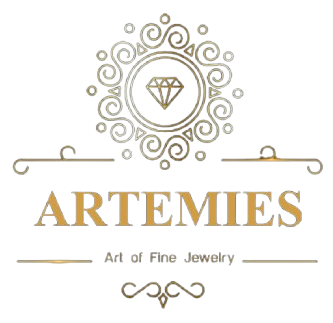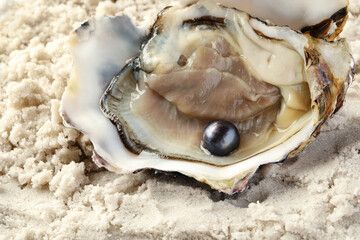
- Jewelry Market
What’s Your Jewelry Worth? Expert Tips on Gemstone Appraisal
Table of Contents
Appraising a gemstone involves assessing its value based on several factors. Here’s a step-by-step guide on how to appraise a gemstone:
1. Identify the Gemstone
Identifying the type and variety of a gemstone is crucial for its appraisal. Here are the refined steps to accurately determine the type and variety of a gemstone:
A. Visual Examination
• Color: Observe the color of the gemstone. This can give initial clues about its type. For example, diamonds are typically clear or slightly tinted, emeralds are green, rubies are red, and sapphires are usually blue but can come in various colors.
• Transparency: Assess whether the gemstone is transparent, translucent, or opaque. This characteristic can help narrow down possibilities.
• Shape and Cut: Different gemstones may be cut in specific ways to maximize their appearance. Note the shape and style of the cut.(see How Gemstone Cuts Impact Value and Appearance.)
B. Gemstone Identification Tools
1• Loupe or Magnifying Glass: A 10x magnification loupe is commonly used to inspect gemstones closely, helping to see inclusions, color zoning, and other features.
2• Microscope: For a more detailed examination, a gemological microscope can reveal minute details that aren’t visible with a loupe.
3• Refractive Index (RI)
• Refractometer: This tool measures the refractive index of the gemstone, which is a unique property for each type. By placing a drop of RI liquid on the stone and looking through the refractometer, you can get a reading that helps identify the gemstone.
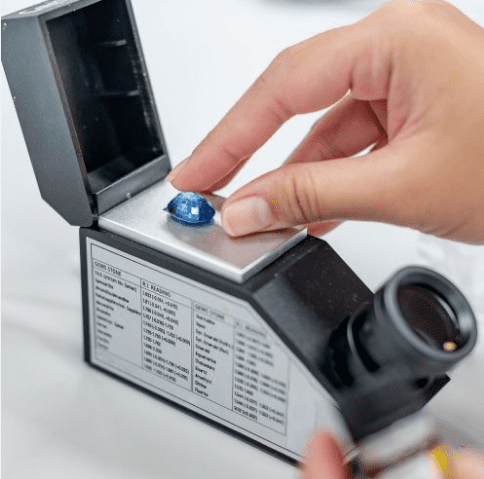
4• Specific Gravity (SG)
• Hydrostatic Weighing: This method involves weighing the gemstone in air and in water to calculate its density. Different gemstones have characteristic densities that can help in identification.
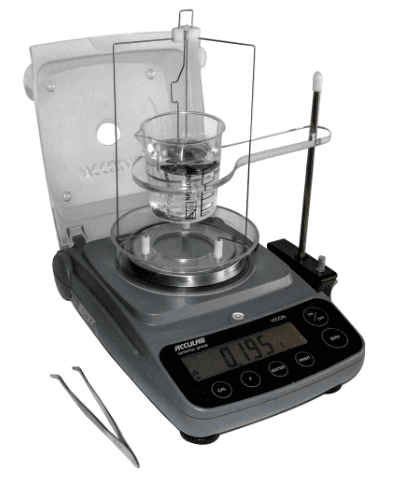
5• Spectroscope: A spectroscope allows you to see the absorption spectrum of a gemstone. Each gemstone type has a characteristic spectrum of light absorption, which can help in its identification.
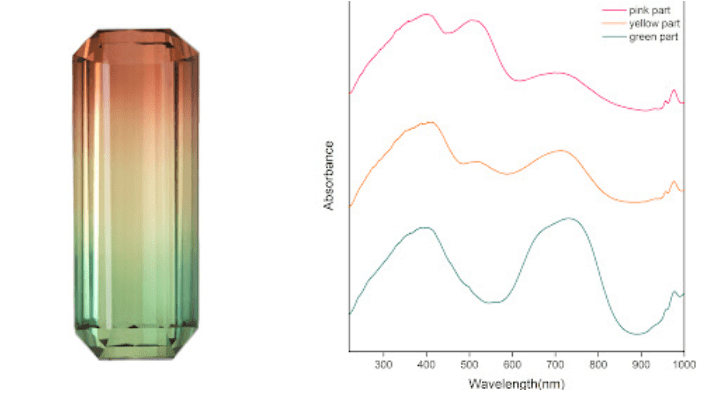
6• Optical Properties
• Birefringence: Some gemstones split light into two rays that travel at different speeds. By examining how light interacts with the gemstone, you can determine if it is birefringent and identify the gemstone.
• Pleochroism: Some gemstones show different colors when viewed from different angles. Using a dichroscope, you can observe this effect to help identify the gemstone.
7. Inclusions and Internal Characteristics
• Growth Patterns: The internal structure and growth patterns observed under magnification can be unique to specific gemstones.
• Natural Inclusions: The presence, type, and pattern of inclusions can indicate whether a gemstone is natural or synthetic(Lab -grown). For example, natural emeralds often have inclusions that are characteristic of their geological formation.
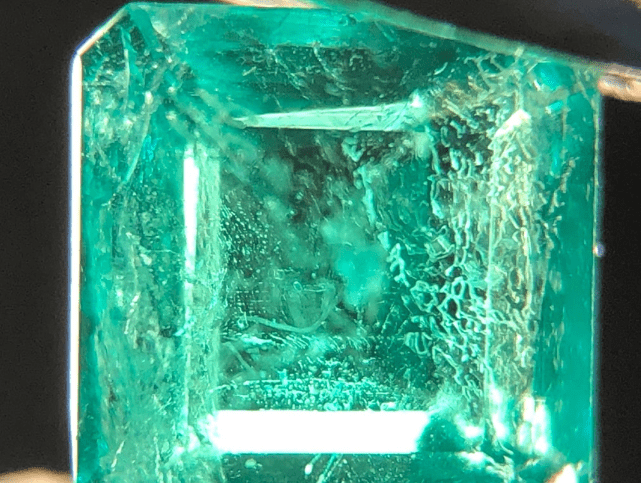
8. Advanced Testing
• X-ray Diffraction: This method analyzes the crystal structure of the gemstone, providing definitive identification.
• Chemical Analysis: Techniques such as Raman spectroscopy or energy-dispersive X-ray fluorescence (EDXRF) can determine the chemical composition of the gemstone.
9. Consulting Reference Materials
• Gemstone Guides: Use gemological reference books and databases to compare findings with known characteristics of various gemstones.
• Expert Consultation: When in doubt, consulting with a certified gemologist can provide an accurate identification.
Example Process
Let's take an example of identifying a potential sapphire:

1. Visual Examination: The stone is blue and transparent.
2. Refractometer Reading: The refractive index measures around 1.76 to 1.77.
3. Specific Gravity Test: The gemstone has a specific gravity of about 4.00.
4. Spectroscopy: The absorption spectrum shows lines characteristic of corundum.
5. Birefringence: Exhibits weak birefringence, consistent with sapphire.
6. Internal Inclusions: Needle-like inclusions (silk) visible under magnification, typical of natural sapphire.
Based on these tests and observations, the gemstone can be confidently identified as a sapphire.
2. Evaluate the 4 Cs
- Carat Weight: Measure the weight of the gemstone in carats. One carat equals 200 milligrams.(see: “Gold: A Comprehensive Guide to Its Properties, Investment Potential, and Sustainable Practices”).
- Cut: Assess the quality of the cut, which affects the gemstone's brilliance and overall appearance. This includes evaluating the proportions, symmetry, and polish. (see: “How Gemstone Cuts Impact Value and Appearance”).
- Color: Examine the gemstone's color, considering hue, tone, and saturation. For diamonds, the color grading scale ranges from D (colorless) to Z (light color). For colored gemstones, the quality of the color can significantly impact value.
- Clarity: Inspect the gemstone for inclusions and blemishes. The fewer and less visible the inclusions, the higher the clarity grade.
3. Assess the Origin
- Geographic Origin: Some gemstones from specific locations are more valuable (e.g., Burmese rubies, Colombian emeralds).(see “birthstone”)
4. Check for Treatments
- Enhancements: Determine if the gemstone has undergone any treatments, such as heat treatment, irradiation, or dyeing. Untreated gemstones are generally more valuable.
5. Evaluate the Cut and Shape
The shape and cut of a gemstone is a significant factor that can influence its value. Here’s how different shapes can affect the value of a gemstone:
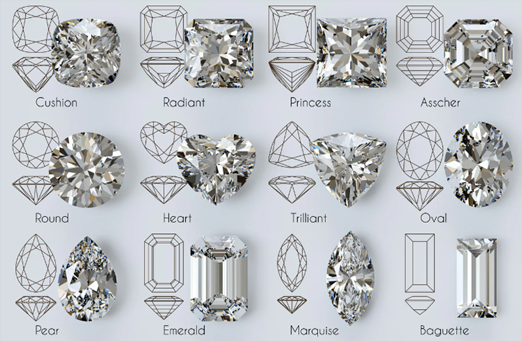
A- Popularity and Demand
• Round Brilliant: The round brilliant cut is the most popular shape for gemstones, especially diamonds, due to its superior brilliance and light performance. This popularity often translates to higher demand and value.
• Princess Cut: The princess cut is also highly sought after, especially for engagement rings. Its contemporary appeal and high demand can increase its value.
• Oval, Pear, and Marquise: These shapes can command higher prices due to their unique and elegant appearance, which appeals to many buyers.
B-Yield from Rough Stone
• Maximizing Carat Weight: Certain shapes allow gem cutters to maximize the carat weight from the rough stone, reducing waste. For example, cushion and emerald cuts often result in higher yield from the rough gemstone compared to round cuts.
• Efficiency: Shapes that preserve more of the rough stone can be more economical to cut, potentially making them less expensive despite being larger in carat weight.
3. Brilliance and Light Performance
• Round Brilliant: Known for their exceptional brilliance and fire, round brilliant cuts reflect light better than most other shapes, making them highly desirable and often more valuable.
• Fancy Cuts: Shapes like pear, marquise, and heart can have unique light performance characteristics, but they may not reflect light as efficiently as round cuts. This can affect their value.
6. Rarity and Exclusivity
• Custom Shapes: Custom-cut gemstones can be highly valuable, especially if they are designed for specific jewelry pieces or have unique artistic elements.
• Unique Shapes: Rare and unique shapes, such as trillion or kite, can be more valuable due to their exclusivity and distinctive appearance.
7. Perceived Size
• Face-Up Appearance: Some shapes can appear larger than others of the same carat weight when viewed from above. For example, an oval or marquise cut can appear larger than a round cut of the same carat weight, potentially increasing its value.
• Elongated Shapes: Shapes like pear, marquise, and oval can create an illusion of greater size, making them more desirable and valuable to those seeking larger-looking gemstones.
8. Symmetry and Proportions
• Ideal Proportions: Gemstones cut to ideal proportions, regardless of shape, will generally have better light performance and visual appeal, thus higher value.
• Symmetry: Symmetrically cut gemstones are more attractive and valuable. Poor symmetry can detract from the gemstone's beauty and decrease its value.(see: How Gemstone Cuts Impact Value and Appearance.)
9. Market Trends
• Current Trends: Market trends and fashion can significantly impact the value of certain shapes. For instance, if a particular shape becomes trendy, its value may increase due to higher demand.
• Classic vs. Trendy: Classic shapes like round and princess cuts tend to have stable demand and value, whereas trendy shapes may experience fluctuations.
Example Comparisons
• Round vs. Princess: A round diamond might be more valuable than a princess cut of the same carat weight due to its superior brilliance and higher demand.
• Oval vs. Marquise: While both can appear larger than their actual carat weight, market demand for oval cuts might currently be higher, affecting their relative values.
• Emerald vs. Cushion: An emerald cut might have less brilliance but is prized for its clarity and elegance, potentially making it more valuable than a cushion cut depending on market preferences.
Generally the shape of a gemstone significantly influences its value due to factors like popularity, light performance, yield from rough stone, perceived size, symmetry, and market trends. Understanding these aspects can help in making informed decisions when buying or appraising gemstones.
10. Measure Dimensions
- Dimensions: Measure the gemstone's length, width, and depth to calculate its proportions.
11. Use Reputable Tools and Techniques
- Refractometer:Measures the refractive index to identify the gemstone.
- Spectroscope:Analyzes the gemstone's spectrum to determine its composition.
- Microscope: Helps examine inclusions and clarity.
- Colorimeter:Measures the color accurately.
12. Compare with Market Prices
- Current Market Trends:Research current market prices for similar gemstones to get an idea of the gemstone's value.
- Historical Prices: Look at historical data to understand price trends over time.
13. Get a Professional Appraisal
- Certified Gemologist: Have the gemstone appraised by a certified gemologist or a reputable appraisal service for an official valuation.
14. Document the Appraisal
- Appraisal Report: Ensure the appraisal includes detailed information about the gemstone, including its weight, dimensions, color, clarity, cut, treatments, and origin.
By following these steps, you can accurately appraise a gemstone and determine its value. For high-value or rare gemstones, it's always best to seek the expertise of a certified gemologist.
in conclusion, accurately determining the value of a gemstone is a complex process requiring a keen eye, specialized knowledge, and advanced tools. By understanding the intricate details of identification, the significance of the 4Cs, and the impact of factors such as origin, treatment, and market trends, you can gain a deeper appreciation for a gemstone's worth. Remember, while self-education is valuable, for high-value pieces, consulting a certified gemologist is essential to obtain a precise appraisal. Ultimately, the true value of a gemstone often lies in its personal significance and the joy it brings, but having a clear understanding of its market worth can provide invaluable insights.
Related Posts
Fall in Love with Jewelry, Stories, and Secrets
Join Artemies Magazine for insider jewelry tips, trend updates, and subscriber-only discounts.

